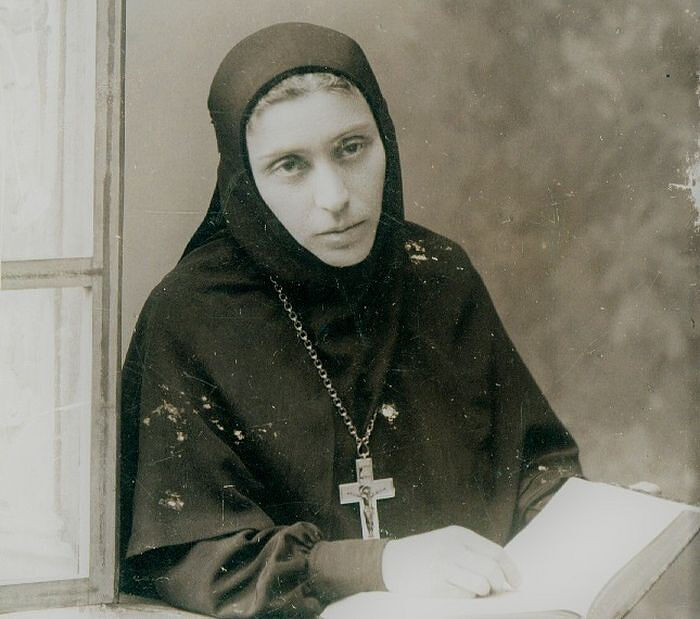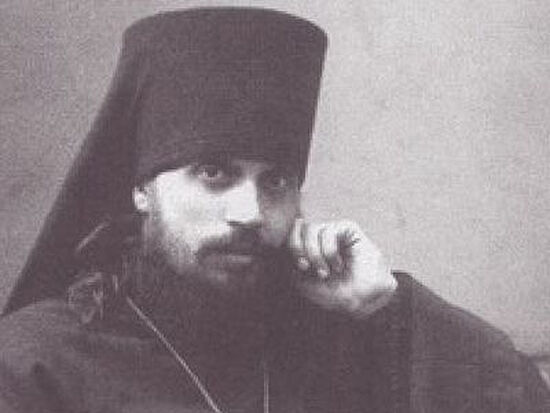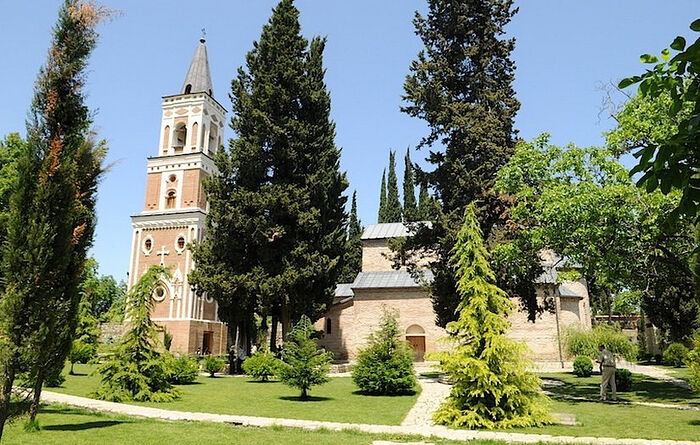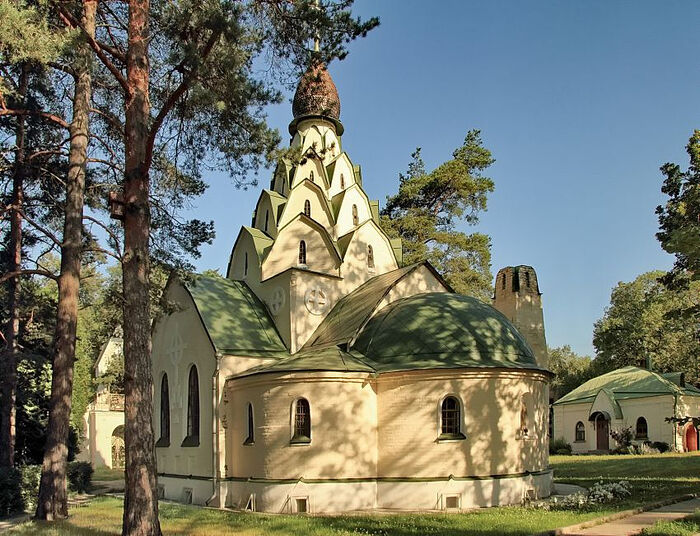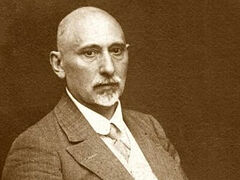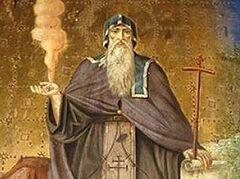St. Tamar (Mardzhanishvili) was a Georgian nun who also labored in Moscow. She was canonized by the Georgian Orthodox Church on December 21, 2016. On December 28, 2017, she was formally added to the calendar of the Russian Orthodox Church, and on October 11, 2023, her name was added to the Synaxis of the New Martyrs and Confessors of the Russian Church. In her honor, we present the following article:
***
In 1892, Abbess Juvenalia (Lovenetskaya) from the Bodbe Monastery in Georgia and two of her young novices came to see Fr. John of Kronstadt at the Holy Resurrection Monastery in St. Petersburg. The purpose of the visit was simple: The famous pastor had sent considerable funds to the recovering monastery, and Matushka wanted to thank him in person.
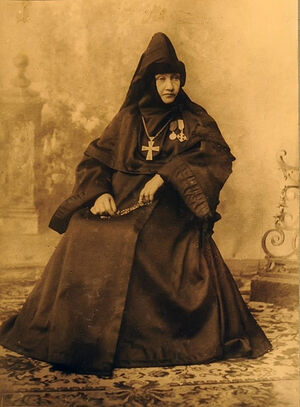 Abbess Juvenalia (Lovenetskaya) When they met, she brought her spiritual daughters, one of whom was named Tamar, to get the Elder’s blessing. Fr. John blessed her, kissed her on the forehead, and said: “Tamara, Tamara, you have chosen the good part.” Later, he asked Abbess Juvenalia for her crosses (she had three), put one around Tamara’s neck and joyfully said, “This what kind of abbess you are to me—take a look at her!”
Abbess Juvenalia (Lovenetskaya) When they met, she brought her spiritual daughters, one of whom was named Tamar, to get the Elder’s blessing. Fr. John blessed her, kissed her on the forehead, and said: “Tamara, Tamara, you have chosen the good part.” Later, he asked Abbess Juvenalia for her crosses (she had three), put one around Tamara’s neck and joyfully said, “This what kind of abbess you are to me—take a look at her!”
As Tamara, the future nun-confessor, recalls, everyone present at this meeting saw this as a special sign and agreed that the holy elder thus predicted her abbacy, and that she would bear three crosses in life.
And so it happened. These three crosses were a foreshadowing of the three monasteries where St. Tamar was destined to become the abbess and bear three difficult podvigs.
God’s call
Schema-Abbess Tamar (Mardzhanishvili) was born on April 13, 1868 (new style), to a wealthy family in the Georgian city of Kvareli. Her mother came from the noble line of the Chavchavadze princes and was the second cousin of the famous public figure, publicist, and future glorified saint, Righteous Ilia Chavchavadze.
Tamara had many military men in her family, including her father, as well as figures from the worlds of art and science. Her brother Kote was the founder of the Georgian theater and her nephew Georgi Eliava was a noted microbiologist. The young Tamara herself was planning to enter the St. Petersburg Conservatory, as she had a wonderful voice and musical talent.
But everything changed when she visited Bodbe Monastery—the resting place of the Equal-to-the-Apostles St. Nina. After her mother died, Tamara and her sisters went to visit their relatives who lived in the city near the Monastery of St. Nina. They went to services in a little house church, where the whole atmosphere—the quiet singing of the nuns, the abbess’ reading of the canon, and most importantly, the work of Divine grace—made such an impression on Tamara that she started thinking she would go to a monastery someday. This is how her spiritual father, Vladyka Arseny (Zhadanovsky), wrote about it in her biography: “She went to the monastery a secular person and returned home with the sense of being a nun.”
Tamara wasn’t able to join a monastery right away. Her family had prepared a secular career for her and didn’t understand the young girl’s (she was twenty-one then) attraction to prayer and worship.
Even after she had gone to a monastery, they decided to return her to the world and sent her a letter asking her to personally come to Tiflis (Tbilisi) to settle matters about her inheritance. The unsuspecting Tamara realized only upon her arrival that it was a trap: From that point forward, she lost the opportunity not only to return to the monastery, but even to visit it and write to Abbess Juvenalia, since all her letters were intercepted.
In the end, with the help of the mother of one of the nuns of Bodbe Monastery, they organized an escape, and then none of the family’s threats or further attempts to bring her back found any success.
Bodbe Monastery
Abbess Juvenalia became a second mother for Tamara, and even settled her into her own cell. She personally took care of the the novice’s spiritual life , became her guardian, and sometimes steered her away from zeal not according to knowledge: “Having gathered her accomplices, ardent sisters like herself, Tamara Alexandrovna started digging caves with them in the mountains next to the monastery, intending to move there for her salvation. Measures were taken to cut off this passion. They sent requests to let them finish what they had started, abundant tears were shed, but the wise abbess insisted and forbade her young spiritual children to continue their dangerous exploits,” reads the life of the Venerable Confessor Tamar.
Over time, Mother Juvenalia began to entrust her spiritual daughter with more and more obediences around the monastery, including document management and accompanying the abbess on trips, directing her energy and abilities in the right direction.
Metropolitan Flavian, the Exarch of Georgia,1 personally tonsured Tamara as a nun and gave her the same name as her spiritual mother—Juvenalia.
In 1902, Abbess Juvenalia was transferred to Moscow as the abbess of the Nativity of the Theotokos Monastery, and after that a decree was issued appointing Sister Juvenalia as the new abbess of Bodbe Monastery. Over the course of twelve years of life in the Monastery of St. Nina, the Mothers Juvenalia (older and younger) had become inseparable—therefore the news of the appointments was a real test. Mother Juvenalia the Younger sent several refusal telegrams to St. Petersburg and twice went to see the Exarch of Georgia, asking him to change the decision. She wrote to influential Church officials asking for support, but nothing helped in the end.
It was difficult for the new abbess at first, but later, thanks to the support of Fr. John of Kronstadt, Mother Juvenalia became a worthy successor to her spiritual mother.
St. Seraphim
The first book that the newly arrived novice Tamar read in Bodbe Monastery was the life of St. Seraphim of Sarov, and she carried a love for the saint with her throughout her entire life.
After she had already become an abbess, Mother Juvenalia sent one of her sisters to Sarov for the uncovering of the relics of St. Seraphim, which took place on August 1, 1903 (new style), and asked her to bring back an icon blessed on his relics. This little icon became a valued sacred treasure for Mother, and many miracles were revealed through it, including the greatest miracle of her life.
On December 10, 1907 (new style), on the feast of the Znamenny Icon of the Mother of God, Abbess Juvenalia and those who were returning to the monastery from Tiflis2 with her were attacked. Some radical highlanders, who had previously sent Mother anonymous threatening letters, fired at her carriage going down Baratashvili Rise.3 Bullets killed the coachman, a guard, and all four harnessed horses, and two monastery workers were wounded. Mother was in the carriage, fervently praying to St. Seraphim of Sarov, holding his icon in her hands. Suddenly, a patrol appeared, which forced the bandits to stop. The whole road and the inside of the carriage were strewn with bullets, the windows were broken, but Mother and her sister-in-law with two children, who were inside, miraculously remained unharmed.
The news of the attack greatly disturbed the hierarchs, and ten days later, for security purposes, Abbess Juvenalia was transferred to Moscow and appointed abbess of the Holy Protection community.
At the beginning of the twentieth century, the Moscow Holy Protection community was the “elder sister” of the now-famous Sts. Martha and Mary Monastery, but at the same time, fulfilling the same duties, the Holy Protection Sisters of Mercy were nuns, unlike the Sts. Martha and Mary sisters. At this time, Abbess Juvenalia became close with Grand Princess Elizabeth Feodorovna and even gave her her beloved icon of St. Seraphim, which she requested for the sickly Tsarevich Alexei.
Life in Moscow and the abbatial duties of the Holy Protection community were a burden for Mother Juvenalia, as they so differed from the monastic way of life of the Monastery of St. Nina in Georgia. After a short time, she decided to settle near Sarov, to be closer to the places of the spiritual labors of her Heavenly protector.
Her miraculous salvation by the prayers of St. Seraphim took place on the feast of the Znamenny Icon of the Mother of God, which is most likely why Mother Juvenalia chose the St. Seraphim-Ponetaevka Monastery to spend the rest of her life at, where St. Seraphim and the wonderworking Ponetaevka Znamenny Icon were celebrated at the same time.
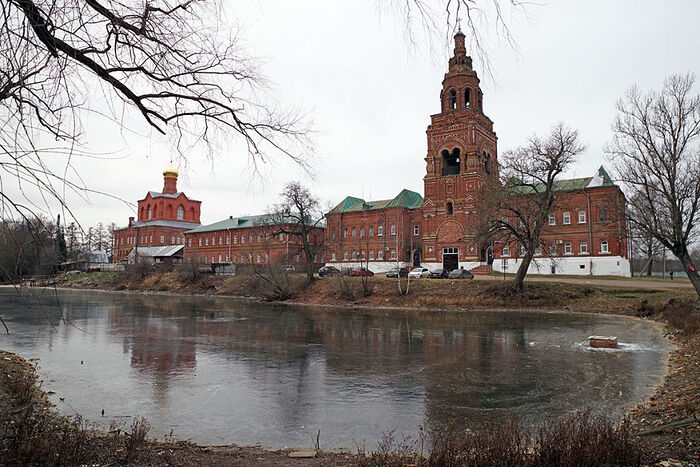 St. Seraphim-Ponetaevka Monastery
St. Seraphim-Ponetaevka Monastery
But her plans were not destined to come to pass. When Mother Juvenalia prayed at the icon of the Mother of God to remain in the Ponetaevka Monastery, she heard a voice say: “No, you won’t stay here, but build a skete not only for yourself, but for others as well.” These words repeated every time she prayed at the icon of the Heavenly Queen, but Mother considered it nothing but a temptation and went to see Elder Alexei in the Zosima Hermitage to confirm her intention.
However, contrary to her expectations, he blessed her to build a skete: “The Queen of Heaven herself will choose the place and provide the means and spiritually arrange everything. You will be but her servant, an instrument…”
St. Seraphim-Znamenny Skete
After numerous trips to various elders, doubts, temptations, prayers, and exhortations, Mother Juvenalia started building the St. Seraphim-Znamenny Skete on one of the sites belonging to the Holy Protection community. In 1910, on the feast of the Apostle Prochorus (the secular name of St. Seraphim), the foundation stone was laid, and in 1912, the skete was consecrated by Metropolitan Vladimir (Bogoyavlensky), of Moscow and Kolomna at that time.
The monastery’s main church was consecrated, of course, to the Znamenny Icon of the Theotokos and St. Seraphim. The lower church was consecrated in honor of the Holy Equal-to-the-Apostles Nina, in memory of Bodbe Monastery. The skete itself had an interesting arrangement: “There are twelve small houses within the walls, according to the number of the Twelve Apostles, with each one under the patronage of one of the Apostles—St. John the Theologian, St. Andrew, and so on. And each has an icon of its patron outside on the enclosing wall. The feast day of each Apostle is like a church feast for the house, whose inhabitants are charged with honoring their Apostle, always praying to him and imitating his exploits. One of the houses served as a common trapeza and kitchen.” Each house could hold up to three sisters, therefore, the total number of sisters was thirty-three, according to the years of the Savior’s life.
Very soon, the specified number of sisters had inhabited the skete, despite the strict typikon prescribing almost complete isolation from the outside world (no outsider was allowed to be in the skete, and the sisters couldn’t leave without a blessing) and the daily liturgical cycle.
On the advice of the elders, Abbess Juvenalia herself wrote a petition to Metropolitan Makary (Nevsky) to be tonsured into the schema, which took place on the feast of St. Dmitry of Rostov in 1916. She was given the name Tamar.
Future hieromartyrs often stayed in the skete: Vladyka Arseny (Zhadanovsky) and Archimandrite Seraphim (Zvezdinsky), who soon became Bishop of Dmitrov.
St. Seraphim-Znamenny Skete lasted only twelve years after its consecration, being closed by the Soviet authorities in 1924. Schema-Abbess Tamar lived at Sts. Martha and Mary Monastery for a time, then, after it was closed, she moved to a village near Serpukhov. Mother found a small house in the village of Perkhushkovo and settled there with ten sisters, continuing her monastic labors in such cramped conditions. Many people turned to Mother Tamar for prayer and assistance, so her life in the village didn’t go unnoticed by the godless authorities.
The end of her earthly path
In 1931, Schema-Abbess Tamar was arrested and exiled to Siberia. Despite the efforts of her brother, the famous director and theater and film actor Kote Marzhanishvili, she couldn’t be rescued. Mother had to walk part of the path to her final destination on foot, on her bad legs. Her already poor health was undermined and she developed tuberculosis, but she continued to pray and endure the hardship of these trials, remaining a lamp of Christ’s faith for those around her.
The owner of the house where she lived, her son, and even the strict commissar to whom Mother Tamar was assigned while serving her term, warmed to her.
Three years later, the confessor returned from exile and moved into a house at Pioneers Station, where she continued to receive people. Two years later, on June 23, 1936, Schema-Abbess Tamar peacefully reposed in the Lord. Her funeral was served by her close spiritual friend Bishop Arseny (Zhadanovsky) in the same house where she lived, and she was buried at the Entrance of the Theotokos Cemetery in Moscow.
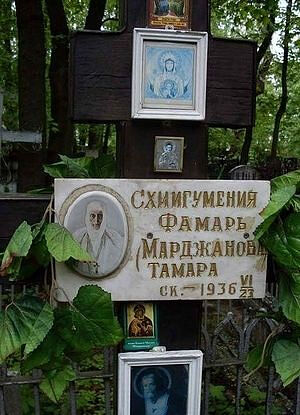 Mother’s grave Seventy-five years after St. Seraphim-Znamenny Skete was closed, on January 15, 1999, on the winter feast of St. Seraphim of Sarov, the first Divine service was celebrated in the newly reopened monastery.
Mother’s grave Seventy-five years after St. Seraphim-Znamenny Skete was closed, on January 15, 1999, on the winter feast of St. Seraphim of Sarov, the first Divine service was celebrated in the newly reopened monastery.
A year later, on January 27, 2000, on the feast of the Equal-to-the-Apostles St. Nina, the Enlightener of Georgia, new sisters moved into the skete.
On December 22, 2016, the Georgian Orthodox Church glorified Schema-Abbess Tamar as a saint. A year later, on December 29, the Russian Church also added the Venerable Confessor Tamar to its calendar.
On June 13, 2018, her relics were uncovered at the Entrance Cemetery and solemnly transferred to the reborn St. Seraphim-Znamenny Skete.
Holy Venerable Tamar, pray to God for us!

